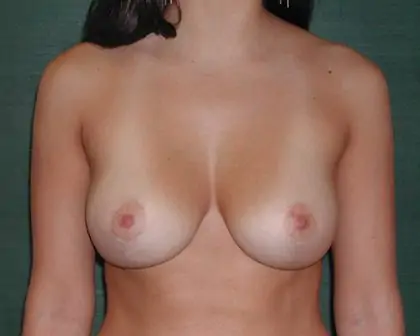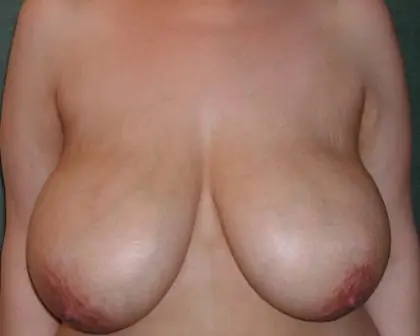Overly large breasts can turn a simple task or activity into a tough one. And, as well as causing pain, they can also interfere with what a woman wears. Chafing and skin issues are common, leading to frequent discomfort. Thankfully, breast reduction can drastically improve these outcomes.
Steven Wallach, MD, FACS is a board-certified plastic surgeon with extensive experience in breast reduction surgery. During your consultation at his Manhattan office, Dr. Wallach will discuss your concerns and goals, and develop a personalized treatment based on your unique needs. He uses the latest techniques to achieve natural-looking results while minimizing scarring.
Breast reduction surgery can provide significant physical and psychological benefits and increased self-confidence. If you are considering breast reduction, schedule a consultation with Dr. Wallach. Call us at (212) 861-6400 or complete our inquiry form to learn more.
About Breast Reduction
Many women across the country and around the world experience discomfort due to overly large breasts. They can interfere with daily life, particularly with exercise, and can cause immense strain on the neck, shoulder, and back muscles. (1) A breast reduction procedure aims to reduce the size of your breasts, alleviate any physical pain caused by their weight, and improve their overall shape and appearance.
Breast reduction surgery is one of the most common plastic surgeries in the United States. Over 100,000 procedures are estimated to be performed annually. (2) But it is important for all patients to understand the scope of the surgery. It is not a weight-loss surgery, and patients should be close to their ideal weight before the procedure takes place. Breast reduction surgeries can remove excess breast tissue as well as lift breasts to provide better size and shape while also alleviating the symptoms of breast hypertrophy. Dr. Wallach performs breast reduction mammoplasty using a limited incision technique to provide minimal scarring as a result of breast reduction procedures.
There are two common skin design patterns for breast reduction. The one chosen for your specific surgery is based on the amount of skin that needs to be removed, the distance the nipple areola complex (NAC) needs to be lifted to place it in an aesthetically pleasing position, and the amount of breast tissue that needs to be removed or repositioned.
Benefits
Breast Reduction surgery is a cosmetic procedure that can provide significant relief to women who experience problems related to large breasts. Breast Reduction surgery is an effective solution that can provide the following benefits:
- Relief from chronic neck, back, and shoulder pain
- Elimination of skin irritation, rashes, and infections caused by large breasts
- Improved posture and balance
- Increased comfort during physical activity
- Enhanced self-confidence and self-esteem
- Reduction in breast size and volume to achieve a more proportionate body shape
- Re-positioning of the nipple and areola for a more youthful appearance
- Minimized scarring using advanced surgical techniques
- Personalized care and attention to ensure optimal results
Candidates
Breast reduction surgery is recommended for women who have overly large breasts that are causing physical discomfort and/or emotional distress. Breast reduction surgery is a popular procedure for women who experience discomfort and pain due to excessively large breasts. The ideal candidates for breast reduction surgery are those who have:
- Breasts that are too large for their body frame
- Chronic neck, back, or shoulder pain
- Skin irritation underneath the breasts
- Difficulty finding clothes that fit well
- Limitations on physical activity due to breast size
It’s important to note that breast reduction surgery is a major surgical procedure and should only be considered by individuals who are in good overall health. During a consultation with board-certified plastic surgeon Dr. Wallach, he will evaluate your medical history and determine if breast reduction surgery is right for you. In addition, he will discuss the potential risks and benefits of the procedure and help you set realistic expectations for the outcome. If you’re considering breast reduction surgery, contact our office at (212) 861-6400 to schedule a consultation with Dr. Wallach.
Personal Consultation
We understand that every woman’s body is unique and requires personalized care. That’s why we arrange an initial consultation with you to discuss your individual needs. If you are considering breast reduction surgery, we offer you a chance to discuss your concerns and evaluate your candidacy for the procedure. During your consultation, Dr. Wallach will review your medical history, examine your breasts, and discuss the options available to help you achieve your desired outcome.
During your consultation, you will have the opportunity to ask any questions you may have about the procedure, recovery, and potential risks. Dr. Wallach and our team will provide you with all the information you need to make an informed decision about breast reduction surgery.
Preparation
Prior to your breast reduction surgery, it is important to follow the preoperative instructions provided by Dr. Wallach to ensure a smooth and safe procedure with optimal results.
- Stop using blood thinners, supplements, and medications that may interfere with healing.
- Refrain from smoking or using nicotine products several weeks before and after surgery, as it can increase the risk of complications and delay recovery.
- Fill any prescription medications in advance and have them ready for after surgery.
- Arrange for transportation and assistance for the first few days after surgery.
- Plan time off work and social activities to allow proper rest and recovery.
Dr. Wallach will also provide you with guidelines on what to wear, eat, drink, and avoid before surgery to promote faster healing and reduce the risk of infection. Follow these instructions closely to achieve the best possible outcome and enjoy the benefits of a breast reduction procedure.
Breast Reduction Procedure
Before your procedure, we will administer anesthesia for your comfort. Breast reduction surgery involves making incisions around the areola and down the breast, allowing Dr. Wallach to remove excess breast tissue, fat, and skin. In some cases, the nipple and areola may need to be repositioned to achieve a natural-looking result. The remaining breast tissue is then reshaped and lifted to create a more youthful and aesthetically pleasing contour.
Breast Reduction Skin Excision Patterns
WISE PATTERN BREAST REDUCTION
The Wise pattern places incisions along the inframammary fold of the breast (the breast crease), a vertical incision from the fold up to the areola border, and an incision around the border of the areola. The resulting incision looks like an inverted “T” or an anchor after final closure. This pattern is usually employed for patients with very large breasts but can be used for almost any reduction volume.
In addition, this technique is commonly used when a patient has poor skin quality and the breast is very loose, or when the nipple has to be raised a significant amount in order for the breast to have a youthful appearance.
VERTICAL BREAST REDUCTION
The vertical breast reduction is similar to the Wise excision pattern procedure but eliminates the inframammary incision. Dr. Wallach will commonly employ a vertical breast reduction technique that minimizes the amount of scarring on the breast using a “lollipop” pattern that uses a circular incision around the areola and a vertical incision down the lower breast. This technique is often used for smaller breast reductions when the patient’s skin quality is good, and the nipple does not have to be raised a long distance.
HORIZONTAL INCISION TECHNIQUE
This is a technique that employs an incision at the breast crease and around the areola. There is no vertical incision from the areola border like used in the Wise or vertical pattern. This procedure is performed using an inferior pedicle technique and can be used for larger breast reductions and long pedicle lengths. A disadvantage of this technique is that the breast can look a bit “boxy” when fully recovered.
WISE PATTERN BREAST REDUCTION TECHNIQUES
There are numerous named reduction techniques employing the Wise skin pattern excision based upon the orientation of the blood supply feeding the pedicle to the nipple areola complex (NAC).
INFERIOR PEDICLE
The inferior pedicle technique is probably the most popular one used today because it is considered the most versatile. Some studies suggest that patients undergoing this technique have the best post-surgical sensation of the NAC and also have the best chance to adequately breastfeed.
SUPERIOR PEDICLE
Is a reasonable approach for patients who only need the NAC moved a short distance. It is good for smaller reductions than what can be achieved with the inferior pedicle technique.
Is a technique that employs a pedicle based superomedially on the chest. It can be used for large reductions and in those with low-hanging breasts.
Other Breast Reduction Techniques
There are other pedicle designs including those using the central mound, the lateral pedicle, the medial pedicle, various bipedicle forms, and the supero-lateral pedicle.
There are many procedures that can incorporate the “lollipop” skin closure. The three most common vertical breast reduction techniques are:
SUPERIOR PEDICLE TECHNIQUE (LEJOUR)
This is a great technique to be used for patients who have moderately good skin quality, require a relatively short pedicle, and do not require a very large reduction. The pedicle is based superiorly and the skin closure results in a lollipop design. Dr. Wallach uses this technique often and has published his modifications on the LeJour technique and has presented it to other surgeons at the Aesthetic Society’s national meeting.
This is a very versatile technique that can be used for larger reductions than the LeJour procedure because the pedicle is turned from the superomedial aspect and more tissue can be removed from the sides and top of the breasts. The closure is similar to the LeJour in that the resulting closure looks like a lollipop.
SPAIR TECHNIQUE (SHORT-SCAR PERIAREOLAR INFERIOR PEDICLE REDUCTION) (HAMMOND)
This is different than the superior pedicle or superomedial techniques described above because the pedicle is inferiorly based. Similar to the inferior pedicle technique using the Wise pattern, more tissue can be removed superiorly than with the above techniques described.
MASSIVE WEIGHT LOSS PATIENTS
Many massive weight loss patients are often not good candidates for a vertical breast reduction technique because they often have poor skin quality and the skin envelope is very loose. For these patients, a Wise incision pattern will often achieve the desired result. For massive weight loss patients, Dr. Wallach has used both types of incision designs to achieve beautiful and natural results for his patients.
LIPOSUCTION ONLY BREAST REDUCTION
Some plastic surgeons perform breast reductions using only liposuction. This limits the need for incisions and scarring, however, in the majority of patients, it will not adequately “lift” the breast or reduce the skin envelope. Thus, the breast will potentially be looser after the procedure. If the breast is primarily fatty tissue, then liposuction can be successful in reducing breast size, but this technique will usually not consistently improve the aesthetic appearance of the breasts. If there is significant ptosis (sagging) and the nipple is low on the breast mound, liposuction-only breast reduction NYC will not provide the lift needed to create a more youthful look.
FREE NIPPLE GRAFT TECHNIQUE
The free nipple graft technique is used for patients that have extremely large breasts and whose nipples are very low on the chest. When the potential pedicle length is too long, there is a risk that the NAC will not survive. Therefore, a free nipple graft technique is an option. A pedicle of tissue is used to restore an aesthetic breast mound. The nipple and areola are removed and replaced on the breasts at an aesthetically pleasing position as a free graft. This technique will eliminate the ability to breastfeed, and may result in partial or incomplete nipple survival. It may also lead to hypopigmentation of the nipple and areola.
Recovery and Results
In general, breast reduction surgery takes between two and four hours to complete with a recuperation time of one to two weeks. Often patients will have a drain in the breasts that is commonly removed a few days to a week after surgery. Patients wear a support bra without an under-wire or a sports-type bra for about three to six weeks before they can go back into an under-wire bra. You may experience some discomfort, which can be easily managed with medication prescribed by Dr. Wallach. Most patients can go back to light duty within 7-10 days and can go back to light aerobics within about 3-4 weeks and more strenuous activity and heavy lifting within 6-8 weeks. During this time, it is also recommended to keep your upper body elevated to reduce swelling.
FOLLOW-UP APPOINTMENTS
You will have follow-up appointments with Dr. Wallach so that he can monitor your healing progress and ensure that you are comfortable throughout the recovery process. Scarring is inevitable, but Dr. Wallach takes special care to make incisions in discrete locations, such as around the nipple or underneath the breast fold, to minimize their appearance.
Once you have fully recovered from your breast reduction surgery, you will notice a significant improvement in your quality of life. You will no longer have to deal with the physical and emotional discomfort caused by excessively large breasts. Your breasts will be more proportional to your body, allowing you to engage in physical activities with greater ease and confidence. Additionally, your clothes will fit better and you will enjoy an overall boost in self-esteem.
If you are considering breast reduction surgery, we encourage you to schedule a consultation with Dr. Wallach to discuss your options and learn more about what to expect during the recovery process.
Cost of Breast Reduction in Manhattan
Dr. Steven Wallach understands that every patient has unique needs and goals when it comes to breast reduction surgery. As such, the cost of your procedure will depend on several factors, including the extent of surgery required, anesthesia, and other related costs. During your initial consultation with Dr. Wallach, he will take the time to assess your individual situation and develop a customized treatment plan tailored to your specific requirements.
Our team believes in transparency and honesty, which is why we will provide you with an accurate estimate of the total cost of your breast reduction during your consultation. We also offer flexible financing options to help make your desired procedure more affordable.
Our goal is to provide our patients with the highest level of care and results. Contact our New York office today at (212) 861-6400 or fill out an inquiry form on our website to schedule your consultation with Dr. Wallach at your earliest convenience.
Read more about breast reduction and other procedures performed by Dr. Wallach by reading his blog.
References
- Sachs D, Szymanski KD. Breast Reduction. PubMed. Published 2021. https://www.ncbi.nlm.nih.gov/books/NBK441974/
- Fisher M, Burshtein AL, Burshtein JG, Manolas P, Glasberg SB. Pathology Examination of Breast Reduction Specimens: Dispelling the Myth. Plastic and Reconstructive Surgery – Global Open. 2020;8(11):e3256. doi:https://doi.org/10.1097/gox.0000000000003256
FAQs
Does breast size affect weight?
I think that if a patient has very large breasts, it may affect their ability to exercise and may impact their weight to some extent.
Can you drink alcohol after breast reduction?
Yes, you can drink alcohol a few weeks after a breast reduction once your surgeon gives you the okay.
Does insurance pay for breast reduction?
Each insurance company may have different criteria for coverage so it may not always cover the cost.
Do you lose feeling in your nipples after breast reduction?
Most patients maintain normal sensation after a breast reduction.
Does weight gain increase breast size?
Yes, if you gain weight, your breasts are likely to grow as well.
Do you lose weight after breast reduction?
The weight you lose is related to the volume of tissue removed during the procedure.
Has anyone had a second breast reduction?
Yes, some patients undergo a second breast reduction for various reasons, like insufficient removal during the first procedure, or weight gain causing their breasts to grow.
How can I reduce my cup size?
The cup size will likely go down after a breast reduction.
How do you know when you need a breast reduction?
Patients that desire small breasts are candidates for a breast reduction. Often patients have symptoms of neck and back pain as well as bra strap grooving and poor posture.
How dangerous is breast reduction surgery?
A breast reduction is a very safe procedure in a healthy patient with a very low risk of major complications
How is the recovery from breast reduction?
Patients do not usually have a lot of pain post-operatively and can often go back to light duty within a week to ten days.
How do breast reductions work?
A breast reduction can be performed as an outpatient and can take between 2-4 hours to complete.
How long do stitches stay in after breast reduction?
I usually use absorbable sutures and these are under the skin and do not need to be removed. There may be drains that are secured with sutures to the skin which is often removed in one week.
How do I know if I need a breast reduction?
Patients that desire small breasts are candidates for a breast reduction. Often patients have symptoms of neck and back pain as well as bra strap grooving and poor posture.
How long does it take for swelling to go down after breast reduction?
The majority of the swelling will go down within 6-8 weeks but there may be some residual swelling for 6 months to a year.
How long does it take to recover from a breast reduction?
Most patients can go back to light duty within 7-10 days and can go back to light aerobics within about 3-4 weeks and heavy lifting within 6-8 weeks.
How painful is a breast reduction?
A breast reduction is usually not that painful. Most patients only complain of some incisional discomfort.
How many cup sizes can you go down with breast reduction?
This depends upon where you are starting from. That is hard to predict and best discussed in person based upon your exam
Is it OK to wear a sports bra after breast reduction?
I prefer patients not to wear an underwire bra for at least 6-8 weeks. I usually have patients wear a loose-fitting sports bra post-op.
How much do breast reductions cost?
The fee will vary from surgeon to surgeon in different geographic regions of the country.
Is it worth getting a breast reduction?
For patients with symptoms of having large breasts, this can be very worthwhile. Of course, it is a personal choice.
Why do breasts grow back after a reduction?
The breasts can enlarge after surgery most commonly as a result of weight gain. It is extremely rare for breasts to just grow further after surgery and not be due to weight gain.
Why do my breasts hurt and feel heavy?
This may be due to the weight of the breasts which can cause stress to the neck and back.
When can I sleep without a bra after breast reduction?
I think that when patients feel comfortable and do not feel the need to have the breasts confined to the bra, then it is okay to sleep without the bra.
When can I wear a normal bra after breast reduction?
I prefer patients avoid an underwire bra for at least 6 weeks.
What is the difference between a breast lift and a breast reduction?
In many ways a breast reduction and breast lift are similar. A breast reduction reduces the overall volume of the breast parenchyma, the excess skin is excised to drape over the gland, and the nipple areola complex is lifted into a more aesthetic position. A mastopexy or breast lift is similar in that the gland is lifted and often parenchymal sutures are used to shape the breast, the skin is then draped over the gland, the excess skin is removed, and the nipple areola complex is raised to a more aesthetically pleasing position. While some tissue may be removed during a breast lift, it is often minimal in most cases. In many ways, the amount of tissue removed is really the biggest difference. There are many different techniques that are used to perform these procedures. The skin can be excised in an inverted T fashion or what is sometimes referred to as an anchor incision. This means that there will be stitches around the areola, vertically from the base of the areola to the breast fold, and also along the inframammary fold in a transverse fashion. A common alternative is a lollipop incision pattern in which there are only stitches around the border of the areola and vertically from the base of the areola to the breast fold, thus eliminating the inframammary incision. The breast parenchymal tissue can be treated using various tissue pedicles most commonly using an inferior pattern, but this can also be vertically, superomedial, or superolateral. Modifications of the breast lift procedures are sometimes performed when a patient desires breast implants as well. A circumareola lift can sometimes be offered when only the nipple has to be raised a short distance.
Am I a good candidate for breast reduction?
In order to say if a patient is a good candidate for a breast reduction, she would have to be seen in person. An examination in person will allow the surgeon to evaluate any asymmetries, and appreciate the weight of the breasts and possible volume that can be removed from each breast. Obviously, a breast reduction is performed on a patient with very large breasts that wants them to be smaller. Commonly, the patient has symptoms of bra strap grooving, neck or back pain, and potentially has rashes underneath the breasts. Symptoms like back pain or neck pain may not improve with a reduction, but there are scientific studies suggesting that it does help many women who have breast reductions. There are many different techniques that can be employed to perform a breast reduction. The skin pattern design often employs the use of an inverted T or anchor type incision, or a lollipop type of incision. Various parenchymal excision patterns can be used. They are named by the orientation of the blood supply feeding the nipple areola complex. The design of the skin pattern and the choice of the pedicle will vary from patient to patient based upon their anatomy and the surgeon’s experience.
Should I get a breast reduction?
The choice to undergo breast reduction surgery is totally up to the patient. If the patient has very large breasts that she desires to reduce whether it is strictly for cosmetic reasons, or because she has symptoms such as bra strap grooving, neck or back pain, or rashes, it is a personal choice. Aesthetically, the breasts can be made smaller by removing the excess tissue and skin to alleviate the excess weight and pressure that heavy breasts can cause, as well as improve the position of the nipple and in most cases reduce the overall diameter of the areola as well. When to have a breast reduction is another issue. Again it is a personal choice. Some women undergo the surgery in their late teens and early 20s before having children, while others undergo the surgery later in life. There is no defined best time in life to have it performed. Patients choose when it fits into their life.
What is the recovery time for breast reduction surgery?
A breast reduction is often performed as an outpatient. This procedure takes about 2-4 hours to complete. Patients often go home wearing light dressings that are covered by a surgical bra. Many surgeons place drains during the procedure which are commonly removed within a week or so after surgery depending upon the amount of drainage. Most patients will be able to go back to light duty within 5-7 days after the procedure, provided that they are healing well and have had no complications. Many patients will be able to go back to light aerobic activity within about 3-4 weeks. Heavy lifting and strenuous workouts can be started about 6-8 weeks after surgery if all goes well. It is always best to check with your surgeon as you are healing to see when it is right for you.
Will a breast reduction help back pain?
Patients with large breasts may have back pain. Back pain can be caused by many different things. Back pain may improve with a breast reduction. Intuitively it makes sense, because surgery will reduce the overall weight of the breasts, thus putting less stress on the back. There are numerous studies in the literature that support this concept. I do tell patients that back pain can occur for many different reasons and that symptoms may not improve after breast reduction. Fortunately, many patients do have improvement of back pain after undergoing a breast reduction.
Can I breast feed after breast reduction surgery?
It is difficult to predict whether or not an individual will be able to breastfeed after breast reduction surgery. Some women who are very small-breasted, before surgery, can produce a lot of milk while some very large-breasted women cannot. Inevitably during surgery some of the parenchyma is removed. There are many patients who can still breastfeed. Again, this depends upon the individual patient.
Will I have normal sensation in my nipples after breast reduction surgery?
Many patients will have some change in sensation after the surgery. Some patients with excessively large breasts do not have sensation in their nipples before surgery. In fact, after breast reduction surgery some of these patients recover nipple sensation although the etiology is not well defined. However, there is a percentage of patients who will have diminished sensation that persists after one year. Nipple sensation may vary a bit. Commonly patients can have a change in sensation right after surgery due to swelling. Most patients will have improvement in the first six to eight weeks after surgery once most of the swelling subsides. However, a patient’s sensation after surgery may be permanently changed. Some studies suggest that 85% have normal sensation at one year after surgery.
What kind of incision will I need for a breast reduction?
There are several types of incisions that can be used to perform a breast reduction. The two most common are a vertical incision closure and a T incision closure. The vertical incision closure is shaped like a lollipop. The incision goes around the border of the areola and then descends in a vertical fashion from the inferior border of the areola down to the breast fold. An inverted T incision, or an anchor incision, is the other popular incision closure. This incision goes around the border of the areola and then extends vertically below the areola to the breast fold, unlike the vertical reductions; it also includes an incision along the breast fold.
What is a vertical breast reduction?
A vertical breast reduction is one of a variety of short scar breast reductions that often refers to the type of closure performed. The name was originally derived from the pedicle or how the nipple areola complex receives its blood supply. The most common types of vertical procedures include those described by Lassus, Lejour, Hall-Findley, and Hammond. Lassus and Lejour are techniques in which the nipple areola complex is supplied by a vertical pedicle. The Hall-Findley procedure uses a supero-medial pedicle, and the Hammond technique that he calls a SPAIR (short scar periareolar inferior pedicle reduction), is an inferiorly based pedicle.
Will I still have fullness after a breast reduction?
It is certainly possible to maintain fullness and a nice shape after performing a breast reduction. Taking out too much tissue may compromise the overall shape.
Will a reduction improve the shape and tighten my saggy breasts?
Yes! Part of performing the breast reduction is not only to reduce the volume of tissue, but also to raise the nipple areola complex as necessary and tighten the skin envelope. So in effect, reduction techniques are commonly used for breast lift techniques. It’s like a two-for-one procedure. If you think of it as a car, the car headlights will hopefully be pointing forward not downward.
Will I need drains after a breast reduction procedure?
Typically, I prefer to use closed suction drains for the majority of my breast reduction patients. They are removed when the drainage is deemed low enough.
Can I just have liposuction of my breasts?
Liposuction alone is performed by some surgeons to reduce the overall volume of the breast. Because the breast consists of fatty tissue and glandular tissue, liposuction can be used to address this fatty portion. So reducing the volume is possible. However, skin tightening or elevating the nipple areola complex cannot be done by liposuction alone. In other words, for patients with very large breasts, low nipple areola complexes, and a lot of skin, liposuction is probably not a good choice. Liposuction may be best for small asymmetries.
How long does breast reduction surgery take?
The length of the surgery can vary depending on the individual case, but typically takes around 2-4 hours to complete.
Will there be scarring after breast reduction surgery?
Yes, there will be some scarring after breast reduction surgery. However, the surgeon will make every effort to minimize scarring by carefully placing incisions in discrete locations.
Can Breast Reduction surgery be combined with other procedures?
Yes, breast reduction surgery can be combined with other procedures, such as a breast lift or liposuction, to achieve optimal results. Your surgeon will discuss the best approach for your individual case during the consultation process.
Can I breastfeed after breast reduction surgery?
It is difficult to predict whether or not an individual will be able to breastfeed after breast reduction surgery. Some women can produce a lot of milk while some women cannot. Inevitably, during surgery some of the parenchyma is removed. There are many patients who can still breastfeed. Again, this depends upon the individual patient.
Are there techniques to limit the amount of anchor type incisions?
For many patients, I have been using a limited incision approach that creates a lollipop type of closure (a circle around the border of the areola and a vertical line from the lower border of the areola to the inframammary fold). In other words, the entire inframammary incision of the anchor type of wound closure is eliminated! This can be done for most patients except for those with excessively large breasts requiring more than 2-3 pounds of tissue to be removed from each breast.
Will I have a boxy breast after a breast reduction?
A boxy breast is the shape of a breast sometimes occurring after a breast reduction. The breast can look somewhat squarish or boxy. In my opinion, the two most common causes are related to 1) the pattern design of the skin excision, and 2) making the breast too tight in the midline. Following the natural curve of the breast will hopefully eliminate the potential for a boxy breast. By not taking out too much skin in the midline will help reduce the risk of developing a boxy breast.
Who is a candidate for a T incision breast reduction?
A T incision or anchor incision breast reduction includes a variety of techniques. The nipple areola complex can be carried on a mound of tissue that supplies blood inferiorly, laterally, centrally, superiorly, or medially. The inferior pedicle design is often considered the most versatile. It can be used for patients with large and long breasts, and also in those whose nipple areola complex has to be moved a long distance.
Can the breasts grow back after reduction?
Unless you are very young (in your mid-teens) and are still growing, your breasts will not likely grow after a reduction. They can get larger if you gain a lot of weight.
How long does it take for a breast reduction to heal?
Most patients can go back to light duty within 7-10 days and can go back to light aerobics within about 3-4 weeks and heavy lifting within 6-8 weeks.
How many pounds is 500 grams of tissue that is removed in a breast reduction?
500 gms of tissue is approximately 1.1 pounds.
Why do people undergo a breast reduction?
A breast reduction is usually performed when women desire smaller breasts. They often complain of neck and back pain.
What happens to the breasts after a breast reduction?
The breasts are often lifted, the volume is reduced, and the areolas are made smaller. Many times, but not always, the symptoms improve.






















